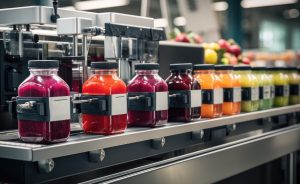
Seventy-eight percent of consumer packaged goods companies and suppliers rank productivity as their top priority. And with the right technology in place, you can boost productivity, transform operational efficiency and improve bottom-line results — especially in the food industry.
In a business where rising labor costs, tough safety regulations and supply chain complexities all impact daily operations, strategic investments in tech can deliver near-immediate returns while positioning your business for sustainable growth.
Ask yourself how investments like these could pay off for your food business:
Virtual optimization. This innovative approach creates virtual replicas of physical production processes, allowing manufacturers to test optimization strategies without disrupting actual operations.
“Digital twins” are beneficial in scenarios where tinkering with actual production lines would be too costly or risky. Dairy processors, for example, may use this technology to optimize pasteurization processes, while meat packers can model different cutting sequences to maximize yield. The result? Reduced waste and greater production capacity without additional capital equipment.
AI and IoT integration. The convergence of artificial intelligence and Internet of Things (IoT) sensors is creating intelligent manufacturing processes that are changing how we do business.
These systems continuously monitor and adjust operational parameters in real-time to help to identify opportunities to maintain optimal conditions while minimizing resource consumption.
Predictive maintenance. Equipment failures in food production can be catastrophic. That’s why predictive maintenance technology uses sensor data and machine learning algorithms to identify potential equipment issues before they cause failures that can drain your business’s finances.
Predictive maintenance also provides insights into equipment performance patterns, so you can best plan a replacement timeline. It’s also helpful in creating detailed maintenance histories to identify recurring issues.
Advanced tracking systems. Food safety regulations and consumer demands for transparency make supply chain technology investments particularly valuable.
Advanced tracking systems provide real-time visibility, enabling rapid response to quality issues and reducing compliance risks. These systems can also create comprehensive digital records that satisfy regulatory requirements.
Quality control automation. Don’t rely on human eyes alone. Automated quality control systems using computer vision and spectroscopy can detect defects, contamination and specification deviations faster and more accurately than human inspectors. QC automation not only improves product quality; it also reduce labor costs and cuts down on human error.
Modern systems integrate with production lines, providing real-time feedback for immediate process adjustments while creating comprehensive quality databases that help identify trends and provide documentation for regulatory compliance.
Future-proofing your food business
New technology empowers smarter decision-making to drive your operational efforts. From labor cost reduction and energy savings to reduced regulatory risk and improved product quality, the right technology investments create competitive advantages that directly impact your long-term profitability and success.
This document is for informational purposes only and should not be considered tax or financial advice. Be sure to consult with a knowledgeable financial or legal advisor for guidance that is specific to your unique circumstances.
